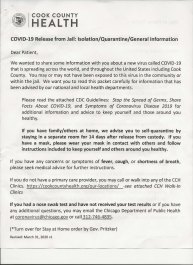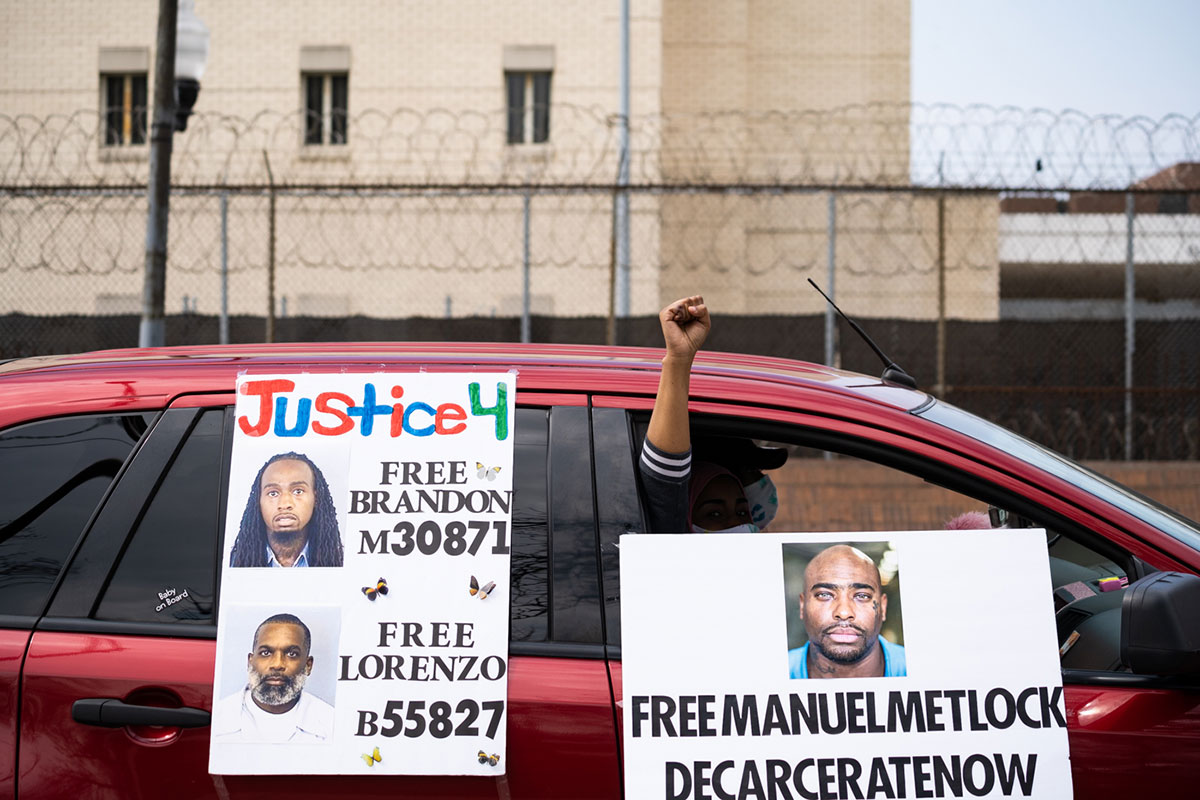It’s difficult to count the days, but he knows she’s coming. His little girl. His first child.
She’s due in the middle of May, but from Zachary Thomas’ position, he can’t tell if it’s March or April and the only way to measure the passing time is by the minutes to his next meal.
“There’s no calendars, there’s no clocks, there’s literally nothing … Everyone forgets what day it is,” Thomas said last week over the phone from inside Division 16, Cook County Jail’s isolation and quarantine facility for detainees who have tested positive for COVID-19. “You ask the [correctional officer] what day it is or what time it is and they just give you an attitude.”
“The way I keep track of time in here is: they wake us up at four in the morning for breakfast, then we get lunch around 10:30 to 11, then we get dinner around 6:30 to 7.”
Inside Division 16, detainees sit roughly three feet apart from each other on their beds, which are secured to the ground. They play cards, chess, watch movies, share bathrooms and even share soap when necessary. They lean on each other’s beds, where they also eat meals, multiple men quarantined there told The Chicago Reporter in phone interviews.
The division is in a barracks that housed an old boot camp program at the jail and was recently set up to provide relief for Cermak Health Services, which has a limited number of beds for infected detainees. As of Monday, there were 171 detainees housed at Division 16, according to the Cook County Sheriff’s office.
Over the phone, you can hear how close they are to each other. You can follow their conversations. You hear them breathe. And you can sense the reverberations of their coughs.

When the area is cleaned, the bleach scent lingers. When detainees need medical assistance, they’re given Tylenol, said Kenneth Hawkins, another detainee in Division 16.
“This is the only time that I’m really afraid for my life because this sickness is here and they not doing nothing about it. They’re giving us Tylenol telling us we gone be OK, but we not going to be OK,” he said. “There’s elderly people I’m in here with having breathing problems, some of them passing out and they’re not doing nothing about it.”
The close quarters within the facility have already come up in a lawsuit and the judge “found no issue with it,” the office said in a statement.
“Beds in the 500-unit isolation facility are not separated by six feet as in other parts of the jail, due to the fact that it houses only people who are confirmed positive for COVID-19 or are convalescing after previously testing positive for the virus,” said Matt Walberg, deputy press secretary for the Cook County sheriff’s Office.
Thomas was released Monday night on electronic monitoring after his family put together $1,000 to make his $10,000 bond on armed robbery and gun charges. After more than two weeks inside the Division 16, he’s been ordered to self-quarantine for another two weeks, as his daughter’s birth looms.
Like him, multiple detainees inside Division 16 say they could be released on electronic monitoring if it wasn’t for bureaucracy. Others don’t see their release as likely, but fear their presence in Division 16 is a pre-trial death sentence.
The jail has already emerged as a top hotspot for the virus across the nation, despite efforts from activists and advocates to release medically vulnerable detainees en masse.
In recent filings, Michael Miller, executive director of the Cook County Department of Corrections, said each person detained in a quarantine tier are receiving new facemasks daily, a supply that should last until early June. He also testified the jail has been able to implement better social distancing measures by utilizing electronic home monitoring, though the equipment has dwindled in recent weeks.
Cermak Health Services did not respond to interview requests for further details on how they’re managing care and recovery of COVID-19 patients from the jail. More than a dozen detainees are currently hospitalized for the disease, according to data from the sheriff’s office.
When Thomas entered Cook County Jail on March 13, there wasn’t a single known case of COVID-19 inside the facility, but that would change rapidly after the first case was found ten days later.
Less than a month after being booked, he would test positive for the virus and be taken to Division 16, where detainees say the only people getting out are dead.
“We’re supposed to be six feet away from each other. It’s 40 people in here with corona right now. Everybody don’t wear they masks. They don’t do none of that,” said Hawkins, another detainee moved to the division after testing positive. “I’m scared for my life. I don’t see how we’re going to get better if y’all keep bringing other people over here that got this.”
In Cook County, the sheriff’s office began COVID-19 screening at discharge on March 16. Along with using a CDC-recommended screening tool, staff take temperatures and provide those being released with informational handouts on next steps, the sheriff’s office said.
To ensure it was “not releasing symptomatic individuals to the community,” staff will be contacting the residences of those being released to ensure they can “continue to self-isolate” if needed and that no one in the house is symptomatic or tested positive, the office said.
The office will work with health department officials to find alternative housing for anyone being discharged while experiencing symptoms or after testing positive who is unable to find stable housing, the office said.
The impossibility of social distancing behind bars
Over the last two months, civil rights attorneys, activists, family of detainees and the Cook County public defender’s office have been working aggressively to reduce the jail’s population with mixed results as cases have escalated to 261 as of April 29. Six detainees at the jail have died after testing positive for COVID-19.
Multiple groups have sued Sheriff Tom Dart alleging social distancing is impossible in the facility, sentencing folks to death before they’ve had their day in court.
“Certainly, we think the evidence is clear the compliance is not happening,” said Sarah Grady, an attorney with Loevy and Loevy. “The jail has indicated that it is taking some steps to socially distance, but actually is not socially distancing those who are most vulnerable, those who require the most amount of medical attention.”
On Monday, U.S. District Judge Matthew Kennelly extended an order to implement new policies ensuring sanitation, testing, social distancing and personal protective equipment for detainees.
“[I]t cannot reasonably be disputed that the Sheriff has undertaken a significant, and impressive, effort to safeguard detained persons in his custody from infection by coronavirus. And based on the record … the Court is satisfied that the Sheriff and his staff have acted in good faith, with the goal of protecting the people placed in his custody, consistent with his obligation to maintain security,” Kennelly wrote in the order.
He also ordered Dart to implement a policy by May 1 that ends group housing and double celling detainees except for those already quarantined after testing positive, those isolated after being tested and those recovering. Those detainees must also be given masks that must be replaced at “medically appropriate intervals.”
The sheriff must also require prompt coronavirus testing for detainees with symptoms and at medically appropriate times, according to the order.
The outbreak is far from under control and the court order forces the sheriff to obtain enough tests for testing decisions to be “based on people’s health, not the availability of testing materials,” Alexa Van Brunt, of the MacArthur Justice Center, said in a statement Monday. “There is significant under testing at the jail, and a very high positive rate.”
There have been 1,212 detainees tested for COVID-19 by April 30, and 538 were negative, according the sheriff’s office. There are currently 4,124 detainees at the jail.
Thomas said he had been awoken at 1 a.m. to be tested a few days after displaying symptoms. He shared a cell with another detainee and was moved to Division 16 by noon the next day.
“They took me out my cell and told me they needed me in the Cermak Hospitals so I went there and then I had to wait in a cell next to another guy,” Thomas said.
Incarceration hotspots across the nation
Nationally, at least 9,437 people in prison have tested positive for the illness with the number of new cases doubling weekly, according to The Marshall Project, which collected data from prison systems in all 50 states and the Federal Bureau of Prisons.
| RELATED:
|
That number is almost certainly an undercount because while most prison systems are releasing numbers on deaths and positive tests, far less is known about the numbers of tests conducted. Little is also known about testing for detainees who were released early in several states like Illinois, where policy changes were made to depopulate jails as the virus began to spread rapidly, according to The Marshall Project.
Since early March, the jail’s population has dropped by more than a thousand people, according to figures from Injustice Watch’s tracker of COVID-19 in the jail, with the biggest drop coming days after March 23, when a judge decided to hold expedited bond hearings for hundreds of detainees, instead of a mass release as advocates had wanted.
Monday’s ruling came after an especially fatal weekend at the jail. Between April 17 and April 20th, three detainees who tested positive for the virus died: 53-year-old Juan Mendoza, 42-year-old Rene Olivo and 64-year-old Karl Battiste.
Still, it’s not enough to make effective social distancing possible, lawyers and activists argue.
“We have spoken to more than 500 people incarcerated at Cook County Jail since the pandemic began, and they have told us the conditions continue to place people’s health in danger,” Sharlyn Grace, executive director of the Chicago Community Bond Fund said in a statement. “The narrative being put forward by Sheriff Dart is not based in reality and continues to put people at risk of further harm. The only way to prevent more deaths is decarceration.”
A bittersweet homecoming
Despite promises of screening upon release, Thomas says his vitals weren’t checked before he was dropped off at his grandmother’s house, where he’ll be quarantined for the next 14 days, he said.
His homecoming was bittersweet. There were no hugs, instead, he’d be taking extra precautions to avoid contact with his family, he said.
“To be honest, it feels like I’m home, but feels like I’m really not home,” Thomas said. “I still have this feeling like I’m being imprisoned. It’s a little tough, but I’m grateful to be out here than in there. I just have to take things for what it is.”
After two days, he started to feel better, but still has migraines and shortness of breath. He’s optimistic that now his symptoms will stay at bay as there was a time in Division 16 he thought he was recovering too.
“First, I had the symptoms then it felt like they were going away for a couple of days. Then they started bringing in new people who caught the COVID-19,” he said. “Once they were bringing in new people, the symptoms felt like they were getting worse. Next thing you know, I’m getting sicker and my body was getting weaker again. I just noticed a lot of symptoms started popping back up every time they bring in fresh people who had caught the COVID-19 instead of isolating them or quarantining them somewhere else.”
Despite the days he’ll need to spend in insolation, if all goes well, his quarantine should be over just a week shy of his daughter’s birth. They plan to name her Danayla.
He’s hoping he’ll be there in person, that is, if he can get permission while on home monitoring.
Correction: An earlier version of this post incorrectly stated the name of the first Cook County Jail detainee to die from COVID-19 and included a claim by Zachary Thomas that he came into contact with him. This story has been updated to reflect the latest testing figures at the jail.




